“With a show like this, you have an opportunity to be experimental,” says furniture maker Sebastian Cox of the pavilion he made with Je Ahn, of Studio Weave, for the Tom Massey-designed Avanade Intelligence Garden. The brief from Avanade and Microsoft, the show garden’s sponsors, was to highlight the benefits of using AI for improving the survival rate of urban trees, one third of which don’t live past their first year, and half of which will last only 10 years. With millions of trees promised for cities around the world, the lack of aftercare is rather pressing.
The sponsors did well to choose Massey, whose designs have a lightness of touch that transcend the sometimes clunky messaging of show gardens (he has won three gold medals at Chelsea). Here, the theme of tree survival is used partly for examining the properties of wood and its close companion, mycelium.
Let’s slip past the crowds and take a closer look:
Photography by Jim Powell for Gardenista.
Above: The oak, ash, and mycelium pavilion was built by contractors Outside Room.
Mycelium, according to the Royal Botanic Gardens at Kew, is a network of thin fungal strands (called hyphae). Je Ahn, Massey’s regular design partner and the architect of the structure, explains that mycelium, molded into building blocks, is not only compostable, but also fairly durable: “It’s coated in bio resin, and as with oiling timber, it will require a certain amount of maintenance. As it matures, it creates a protective sheen, like a mushroom. The building is designed to be completely breathable. You can see the back of it is oiled lattice, so when it rains, it all seeps in, but it dries out very quickly.”
Because this is a show garden, and essentially an experiment, the building is not intended to last forever (mycelium blocks can last between five to eight years outdoors). “One of the our concerns is not that it might not last very long, but actually the opposite: that too many materials that are used in building do last too long in the environment,”he says. The frame of the building is oak, with interior uprights and lattice made from ash that was felled after suffering from ash dieback (caused by a different kind of fungus).
 Above: Fomes fomantarius, or horseshoe fungus, grows on trees and was used as the basis of the mycelium materials used in the building.
Above: Fomes fomantarius, or horseshoe fungus, grows on trees and was used as the basis of the mycelium materials used in the building.
“Mycelium is simple, and easy to grow,” continues Je. The expensive part is making the mold that is used for the mycelium panels on the exterior. “It grows within a couple of weeks, it’s really lightweight, and you just peel it off the mold and pop it in.” Mycelium of horseshoe fungus feeds off the wood waste material that went into building the structure, from timber to wood shavings. There is a lot of joinery inside, as well as furniture made by Sebastian, who makes some tea while giving us background on his personal approach.
 Above: The pendant lamp (Tom Massey is in the background), available through Sebastian Cox, is made from chipped goat willow, with mycelium as a binding agent.
Above: The pendant lamp (Tom Massey is in the background), available through Sebastian Cox, is made from chipped goat willow, with mycelium as a binding agent.
“I’ve been producing the light [with mycelium] since about 2017, and last summer, Je and Tom said, ‘Would you be interested in scaling that up and building with it?’ ” Sebastian recalls. “I’ve always wanted to challenge the sort of material culture that we have today, and I’m doing that through offering this slightly weird material. We need to radically reshape our material culture, and part of that is to get comfortable with biomaterial as a resource. ”
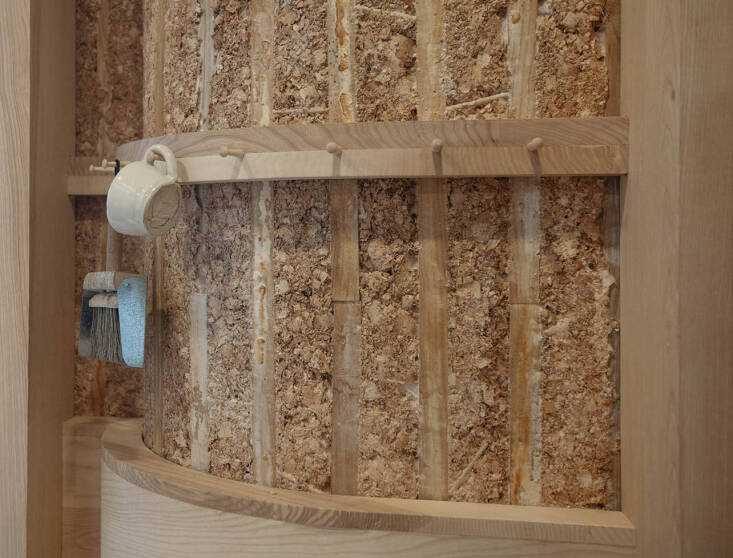 Above: Four cups of tea later. The curved side of the building proudly reveals its construction materials.
Above: Four cups of tea later. The curved side of the building proudly reveals its construction materials.
Reminiscent of medieval wattle and daub, mycelium is the binding agent. “Goat willow wood chip has been inoculated with the mycelium, and it’s strengthened with these vertical wooden ribs embedded in the panels. The ash strips have been completely encased by the mycelium.
“Mycelium has incredible properties in that it’s able to break through wood. Its aim is to ingest the wood, breaking it down to extract its nutrients. We allow that process to go on for a bit, and then we take it out and dry it, and in drying it, we kill the mushroom. They leave behind their entangled hyphae, which are holding it all together.”
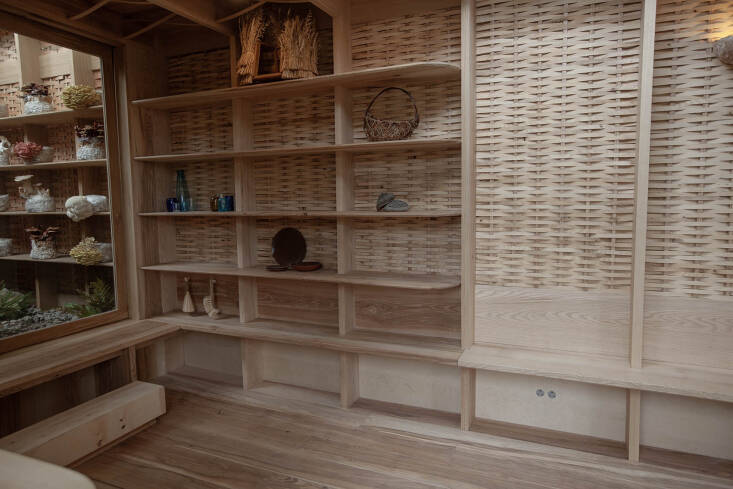 Above: The harmonious interior combines English and Korean aesthetics.
Above: The harmonious interior combines English and Korean aesthetics.
“I love exposing construction,” says Sebastian. “This is where a pavilion is such an exciting thing to make, because there’s no requirement for draft exclusion, or insulation, or any of these concerns. So we can have the actual structure of the building as a decorative element.”
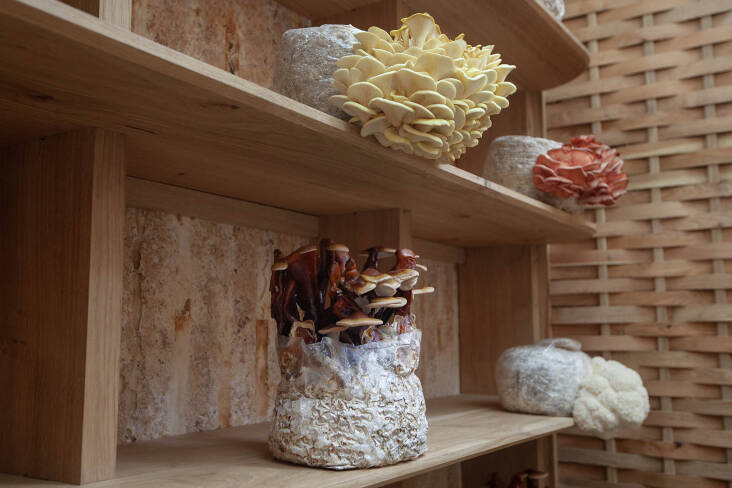 Above: Fungi grown by Sebastian’s friends, mushroom farmers in Canterbury. They produce it for food and medicine suppliers.
Above: Fungi grown by Sebastian’s friends, mushroom farmers in Canterbury. They produce it for food and medicine suppliers.
The interior courtyard at one end of the pavilion was designed by Je, for displaying other types of fungi, cultivated for medicine and food. “It’s a lot of different moments,” says Je, who is Korean, and was thinking of home as he was designing it.
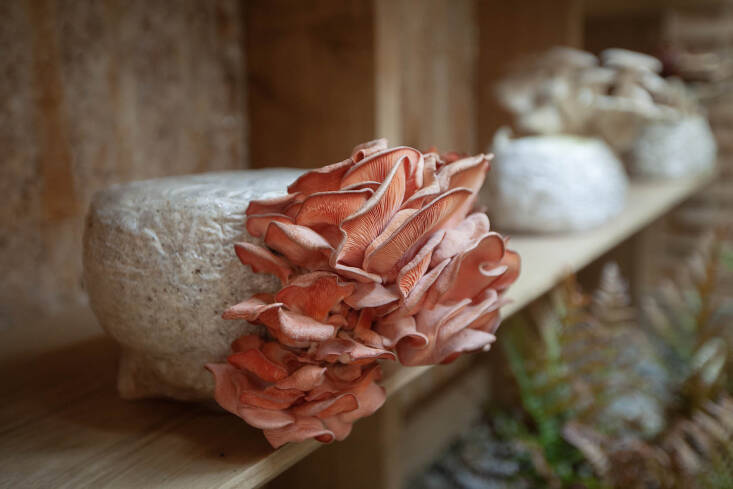 Above: Pink oyster mushroom (Pleurotus djamor), grown as a food.
Above: Pink oyster mushroom (Pleurotus djamor), grown as a food.
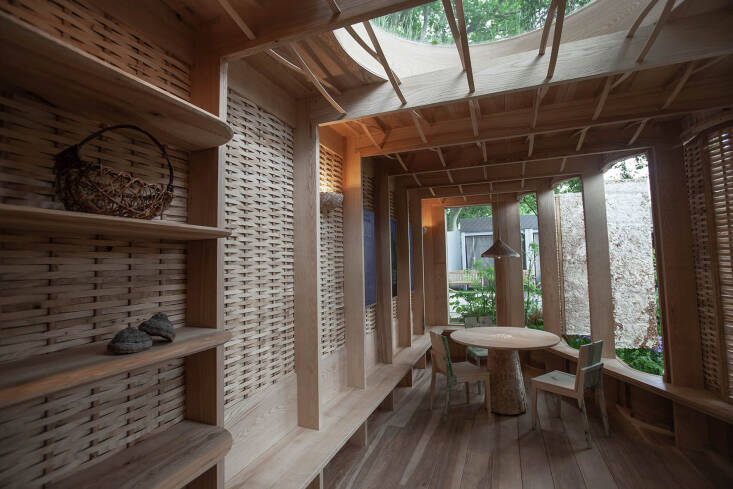 Above: The other end of the pavilion, the ceiling and skylight gently woven with ash strips.
Above: The other end of the pavilion, the ceiling and skylight gently woven with ash strips.
Sebastian started using mycelium in his determination to use every possible byproduct from the four-acre woodland that he runs regeneratively in Kent. “I was always keen to find a use for every single one of the trees that we cut when we’re managing it,” he says. “And one of the species that we can’t use for furniture is goat willow. So I found that mycelium offered a really good binding agent for goat willow wood chip.”
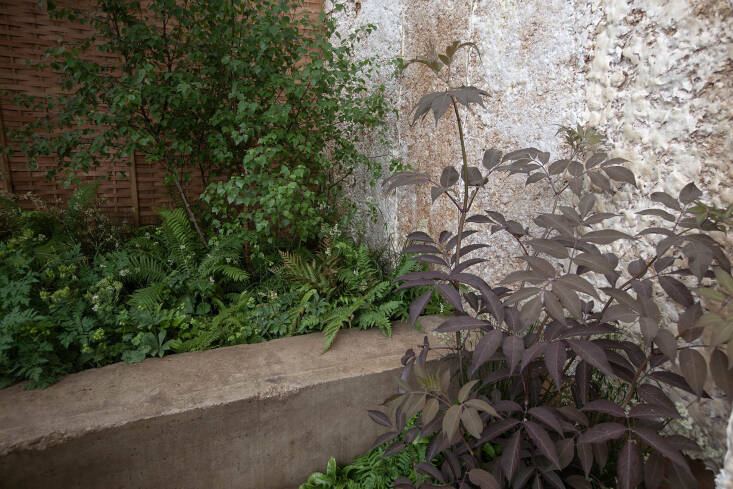 Above: Count mycelium as a good backdrop for plants, among its other qualities.
Above: Count mycelium as a good backdrop for plants, among its other qualities.
‘It’s a temporary structure, so it lends itself to something that feels ephemeral,” says Sebastian. “Mycelium seems like the perfect material for that.”
See also:



